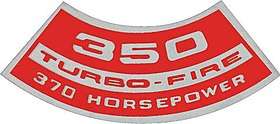Chevrolet LT-1
The LT-1 was a Small-Block engine produced by Chevrolet between 1970 and 1972. It was available exclusively in the sport (Corvette) and pony (Camaro) lines and was produced in relatively low quantities. It is regarded today as one of the greatest Chevrolet Small Blocks, an engine that has been in production since 1955.
 LT-1 air-cleaner decal | |
| Overview | |
| Manufacturer | General Motors |
| Production | 1970-1972 |
| Layout | |
| Configuration | Naturally aspirated 90° V8 |
| Displacement | 350 cu in (5.7 L) |
| Cylinder bore | 4 in (101.6 mm) |
| Piston stroke | 3.48 in (88.4 mm) |
| Valvetrain | OHV 2 valves x cyl. |
| Compression ratio | 9.0:1, 11.0:1 |
| Combustion | |
| Fuel system | Carburetor |
| Fuel type | Gasoline |
| Cooling system | Water-cooled |
| Output | |
| Power output | 255–370 hp (190–276 kW) |
| Torque output | 379–392 lb⋅ft (514–531 N⋅m) |
History
Chevrolet introduced the 350 cu in (5.7 L) LT-1 in 1970, making it available in both the Corvette and Camaro. In the Camaro, the engine was available only through the Z/28 option. It was the first year that the Z/28 option consisted of a 350 cu in (5.7 L) engine, as between 1967 and 1969 the option gave a 302 cu in (4.9 L) motor. The LT-1 was also available in the Corvette both as an engine option and as part of the high-performance ZR-1 option. Between 1970 and 1972 only 53 Zr's were produced, making it one of the rarest Corvettes. The LT-1 had an 11.0:1 compression ratio, Holley 780 cu ft/min (22 m3/min) 4-barrel carburetor, and solid lifters. For the first year the LT-1 was rated at 370 hp (276 kW) in the Corvette and 360 hp (268 kW) in the Camaro. Despite the disparity in ratings, there was no difference between the engines.
In 1971 the compression ratio was decreased to 9.0:1 and horsepower decreased to 330 hp (246 kW), now the same in Corvette and Camaro. A net horsepower rating of 275 hp (205 kW) was also given. In 1972 the rating decreased again, now to a net of 255 hp (190 kW). Gross horsepower was not given in 1972.
In 1970 a Nova could also be ordered with an LT-1 via a Central Office Production Order (COPO). Fifty of these were ordered by Don Yenko at Yenko Chevrolet and were converted into Yenko Deuces. Yenko also converted another 125 L65 Novas into LT-1 Deuces. Another two COPOs were ordered by Central Chevrolet-Oldsmobile in London, Ontario, and were left as-is.
LT1
In 1992 General Motors introduced the LT1, 350 cu in (5.7 L) Small Block whose name was a tribute to the original LT-1. This engine was available through 1997. In a dynamometer test conducted by Super Chevy comparing a 1970 LT-1 and a 1996 LT1, the old motor produced 353 hp (263 kW) at 5,600 rpm and 392 lb⋅ft (531 N⋅m) of torque at 4,100 rpm, while the new motor produced 350 hp (261 kW) at 5,700 rpm and 379 lb⋅ft (514 N⋅m) of torque at 3,800 rpm.
Production numbers
| Camaro | Corvette | Nova (COPO) | |
| 1970 | 8,733 | 1,287* | 52**** |
| 1971 | 4,862 | 1,949** | |
| 1972 | 2,575 | 1,741*** |
- * 25 of these were ordered with RPO ZR1.
- ** 8 of these were ordered with RPO ZR1.
- *** 20 of these were ordered with RPO ZR1.
- **** 50 of these were converted into Yenko Deuces.
References
- Holdener, Richard. "1970 GM 350 Small-Block Engine - Clash of the Small Block Titans." In Super Chevy Online. 8 June 2010. http://www.superchevy.com/how-to/vemp-1008-1970-gm-350-small-block-engine/.
- Koch, Jeff. "COPO Gigio - 1970 Chevrolet Nova." In Hemmings Muscle Machines. June 2005.
- Mattar, George. "1970 Corvette LT-1: Best small-block ever?" In Hemmings Motor News. December 2007.